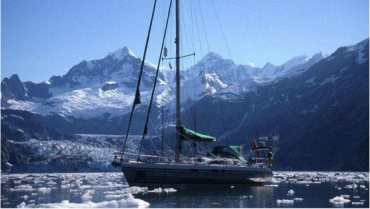Two waves of people from the North Atlantic descended on America. First, one thousand years ago this continent was explored by amongst others, Leifur Eiríksson. Then, in 1874, one of Leifur’s descendants, Jóhann Elíasson Straumfjörð, made the voyage across the Atlantic with the hundreds of people from Iceland, settling finally in 1876 in Mikley (Hecla), Engey, and near Lundar, Manitoba.
Now, two of Jóhann’s descendants, Jóhann Straumfjord Sigurdson and his nephew, David Frederick Collette, will follow a different route and complete a journey that was started before Christopher Columbus was born. They plan to sail from Churchill, across Hudson’s Bay, through Hudson Strait, around Baffin Island, across to Greenland and then on to Iceland.
Their journey will be “Fara Heim”. In Icelandic, að fara heim means “going home”. Their dream has been to experience the adventure of sailing back to Iceland based on the uncharted waters of history which states that the Nordic people did enter North America through Hudson´s Bay and into the heart of North America. Such a voyage was possible one thousand years ago; such a voyage is possible today.
The modern “Vikings” will use contemporary equipment centered on a state of the art 40 ft. aluminum sailboat specially outfitted for Arctic Expeditions. To allow as many people as possible to
participate in this project the plan is to base the vessel in one of the first settled areas, “New Iceland” on Lake Winnipeg for the summer of 2012. The boat would then be transported by rail to Churchill from where it will begin its voyage of re-discovery.
The celebrated journey during the spring and summer of 2013 will provide the expedition with the ability to accept participants on board for different portions of the sail. The two expedition leaders,
Jóhann and David, would remain on the ship for the entire voyage and share their adventures and findings via the modern version of the Sagas, the Internet.
During this time, the project leaders will be researching historical data for clues of possible routes taken and stops made through the northern Arctic region. Several known and suspected Viking locations will be visited and information updated.
Interviews with Inuit Elders and local knowledge and history on this lost chapter of Viking exploration will be documented for future follow-up investigations. The deck of a small sailing vessel is the perfect platform to “see” the Arctic as the Vikings saw it.
The anticipated success of this initial voyage may result in annual trips between Iceland and Canada to focus attention on the myriad of unanswered questions and the mystery of the Viking journeys to the Americas.
Join in the adventure by visiting www.faraheim.com


Comments
article Next
article